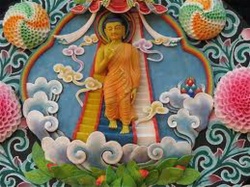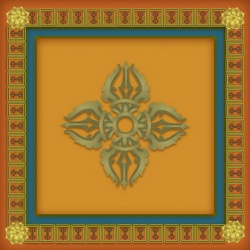Piyadassī Buddha
1. Piyadassī
The thirteenth of the twenty four Buddhas. He was born in Sudhañña (Sudassana) and his mother wasSucandā (Candā). He was called Piyadassī because he showed many pleasing miracles.
For nine thousand years he lived as a layman in three palaces: Sunimala Vimala andGiriguhā (Giribrahā).
His wife was Vimalā and his son Kañcanavela (Kañcana). He left home in a chariot and practised austerities for six months. He was given milk rice by Vasabha's daughter and grass for his seat by the Ajīvaka Sujāta.
His, bodhi was a Kakudha tree. Among his converts were the deva king Sudassana and the elephant Donamukha.
A monk named Sona conspired with Prince Mahāpaduma to kill the Buddha, Donamukha being the elephant they used in their unsuccessful plot. cp. Nālāgiri.
Piyadassī's chief disciples were Pālita and Sabbadassī among monks and Sujātā and Dhammadinnā among nuns, his constant attendant being Sobhita. Sannaka and Dhammika were his chief lay patrons among men, and Visākhi and Dhammadinnā among women. He lived for ninety thousand years and died at Assatthārāma, his thūpa being three leagues in height.
The Bodhisatta of that time was a brahmin named Kassapa, and he built a monastery for the Buddha at a cost of one hundred thousand crores. Bu.xiv.1ff.; BuA.172ff.; J.i.38f., etc.
2. Piyadassī
A Pacceka Buddha. M.iii.69; Ap.i.106.
An arahant. He was present with sixty thousand others, from Jetārāma, at the foundation ceremony of the Mahā Thūpa (Dpv.xix.15; Mhv.xxix.32). He stood on the north east side at the ceremony, and at the close of it he preached to Dutthagāmanī. Ibid., 65; MT. 531.
4. Piyadassī
A setthi of Sudassananigama, whose daughter gave milk rice to Sikhī Buddha. BaA. 201.
5. Piyadassī
A Thera of Ceylon, incumbent of the Devarāja vihāra. He was a pupil of the grammarian Moggallāna and wrote the Pāli grammar, Padasādhana. P.L.C. 205.
6. Piyadassī
A name for Dhammāsoka.

